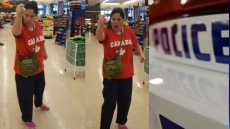VICTORIA — Aboriginal artwork, regalia and ancestral remains taken over centuries from British Columbia First Nations and placed in museums, universities and private collections must come home, Premier Christy Clark said Tuesday.
Clark chose National Aboriginal Day to announce a joint government, First Nations and Royal B.C. Museum effort to repatriate aboriginal items that were removed from the province.
The premier said there is a treasure trove of artifacts and ancestral remains from B.C. First Nations scattered around the world and she wants to help get them back.
Flanked by about a dozen First Nations chiefs and aboriginal leaders, Clark said cultural items, of which many are human and grave remains, are trapped and crying to return to their homes.
"It is long past time that those items of such spiritual significance to First Nations in B.C. found their way home to those communities," Clark told a news conference at the museum. "It is time for those institutions that have taken them away to give them back."
Clark said when she visits museums around the world and sees B.C. aboriginal items she wonders why and how they left the province.
"First Nations in B.C. over many centuries saw grave robberies, saw ceremonial regalia, shamanistic materials, grave goods and human remains taken from their territory and their homes and (moved) into public museums, private collections and universities all over the world," Clark said.

The premier has written to U.S. President Barack Obama asking him to extend to B.C. the rights under the Native American Grave Protection Act that makes it law to return human remains. She said the law should also include items beyond human remains.
"These items and remains should be returned to their original home, according to the wishes of indigenous peoples," Clark's letter stated. "It is the moral thing to do."
First Nations Summit Grand Chief Ed John said many treasures were wrongfully taken and in some cases stolen, including the sacred burial remains of ancestors. He said many First Nations people have been mourning the loss for years.
"Sometimes when it is housed in a place (museum) like this, as beautiful as it may look, you know that those spirits are feeling locked up and crying," he said. "This step around returning and repatriation some of these items is important, some of these are sacred objects."
Jack Lohman, chief executive officer of the Royal B.C. Museum, said the museum will work with the province and First Nations to identify items and have them returned. He said the museum has offered to store the items on a loan-only basis for the First Nations.
Some items have already been returned, including ancestral remains to the Victoria-area Tseycum First Nation from the American Museum of Natural History in New York and a totem pole to the Haisla Nation on the northern coast from the Museum of Ethnography in Stockholm.



